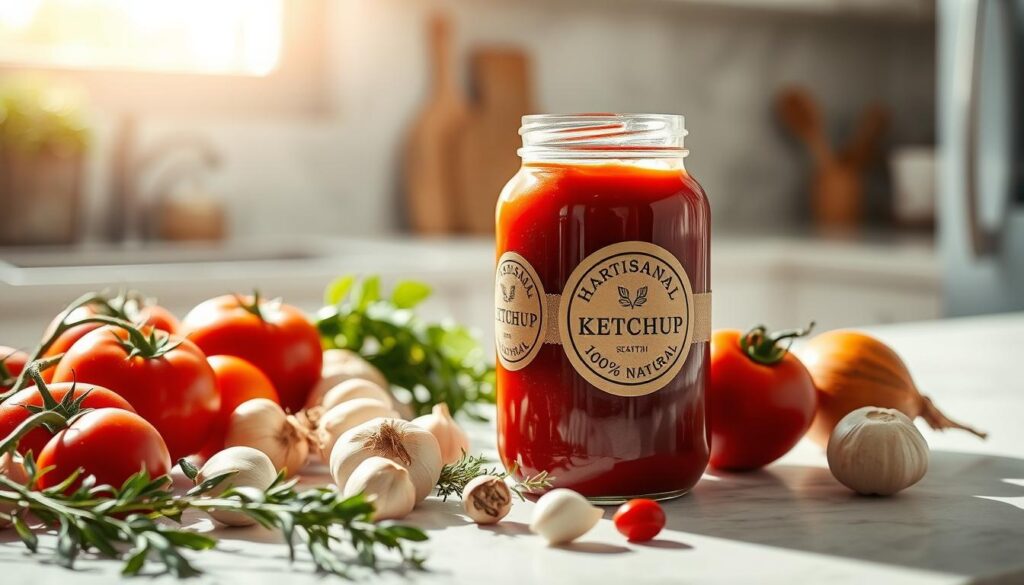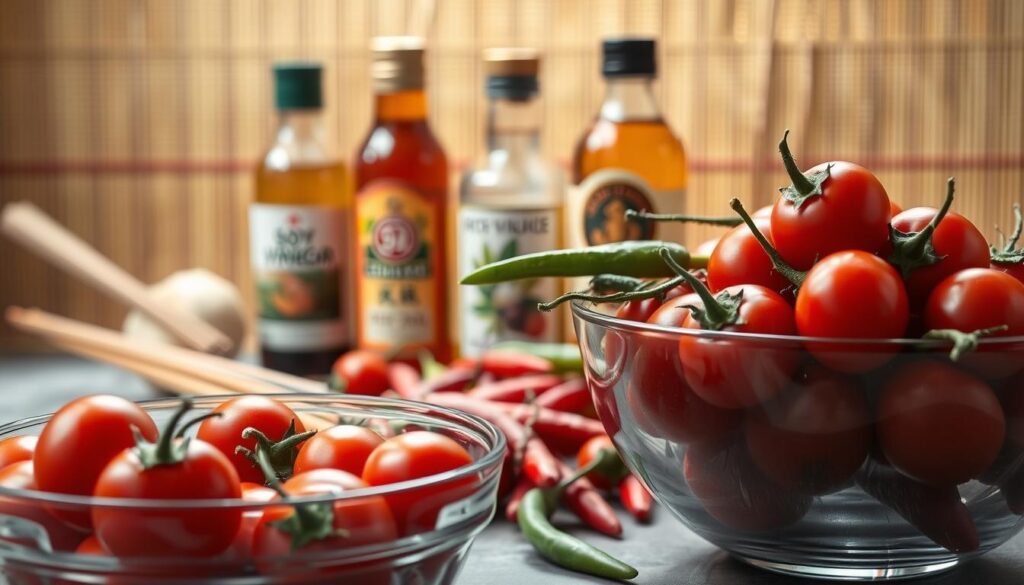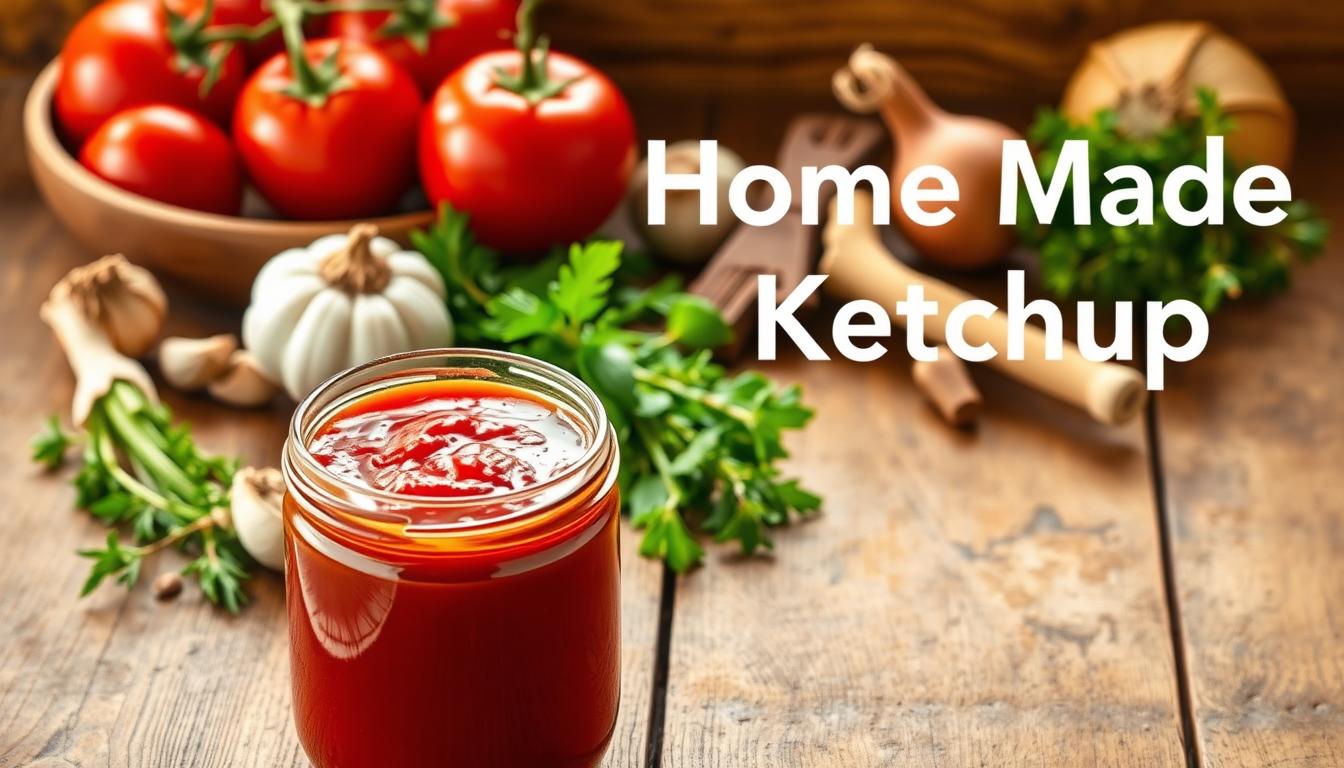Every summer, my grandmother’s kitchen became a magical place. The smell of tomatoes and spices filled our home. It made me love making DIY ketchup recipes.
Imagine making your own ketchup with fresh ingredients. This guide will show you five easy recipes. You can make homemade condiments, whether you’re a pro or just starting out.
Homemade ketchup tastes better than store-bought. You’ll learn the basics of making ketchup. This way, you can make your own special flavors.
Start your ketchup-making journey today. It’s a mix of tradition, taste, and your own creativity. You’ll learn to make everything from classic ketchup to new flavors.
The History and Evolution of Ketchup Making
Ketchup has a long and interesting history that spans centuries and continents. Your favorite tomato ketchup recipe has roots that are more complex than you might think. The condiment we know today started as something very different.
Early Ketchup Variations Before Tomatoes
Before tomatoes, ketchup was a very different sauce. It had unique ingredients that might surprise you:
- Fish-based sauces from Southeast Asia
- Fermented ingredients like pickled fish
- Exotic spice mixtures from trading routes
The Birth of Modern Tomato Ketchup
In 1812, American scientist James Mease made the first tomato-based ketchup. This change made people think differently about organic ketchup and sauce making.
Heinz’s Impact on Commercial Ketchup
In 1876, Heinz introduced bottled ketchup. This changed the culinary world forever. Their tomato ketchup recipe set new standards for taste, consistency, and quality.
“Ketchup is not just a sauce, it’s a cultural phenomenon” – Food Historian
From its humble start to a global favorite, ketchup shows a remarkable culinary journey. It continues to delight people’s taste buds all over the world.
Essential Ingredients for Home Made Ketchup
Making natural ketchup from scratch is all about the right ingredients. You start by picking the perfect base, adding seasonings, and enhancing flavors.
Fresh vs Canned Tomato Options
Choosing the right tomatoes is key for your homemade ketchup. You have two main choices:
- Fresh Tomatoes: Roma or San Marzano tomatoes give a strong flavor
- Canned Tomatoes: They offer consistent quality and are easy to use, especially when fresh tomatoes are not in season
Vinegar and Sweetener Choices
Finding the right mix of tangy and sweet is crucial for great ketchup. Here are some options:
- White vinegar for a classic taste
- Apple cider vinegar for a richer flavor
- Sweetener options: white sugar, brown sugar, or honey
Essential Spices and Seasonings
Spices are what turn your tomato mix into real ketchup. Important seasonings include:
- Onion powder
- Garlic powder
- Ground black pepper
- Celery salt
- Mustard powder
Trying out these ingredients lets you make a ketchup that’s better than store-bought. It’s all about personalizing your flavor.
Classic American-Style Ketchup Recipe
Making ketchup at home is easier than you think. This homemade tomato sauce will give your condiments a fresh taste. It’s better than store-bought.
To make the perfect ketchup, you need a few key ingredients. They mix together to create that tangy-sweet flavor we all love. The secret is using quality ingredients and the right cooking method.
Ingredients You’ll Need
- 6 oz tomato paste
- 1/2 cup water
- 1/4 cup apple cider vinegar
- 2 tablespoons honey
- 1/2 teaspoon onion powder
- 1/4 teaspoon garlic powder
- 1/2 teaspoon salt
Cooking Steps
- Combine all ingredients in a medium saucepan
- Whisk thoroughly to eliminate any lumps
- Simmer on low heat for 20 minutes, stirring occasionally
- Remove from heat and let cool completely
- Transfer to a glass jar and refrigerate
Your homemade tomato sauce ketchup will last up to two weeks in the fridge. Try different spice levels and sweetness to make it your own.
| Ingredient | Quantity | Purpose |
|---|---|---|
| Tomato Paste | 6 oz | Base flavor and thickness |
| Apple Cider Vinegar | 1/4 cup | Tanginess and preservation |
| Honey | 2 tablespoons | Natural sweetness |
Pro tip: For a smoother texture, blend the cooled ketchup in a food processor. This will make it restaurant-quality, impressing your loved ones.
Benefits of Making Your Own Ketchup at Home
Making your own ketchup is a fun journey in your kitchen. It brings many benefits that store-bought ketchup can’t. You get to control the ingredients and customize the flavors, making it a rewarding experience.

Complete Ingredient Control
With homemade ketchup, you decide what goes in. Commercial ketchups often have lots of sugar and preservatives. Your homemade version lets you:
- Reduce sugar content
- Use organic tomatoes
- Eliminate artificial preservatives
- Choose natural sweeteners
Cost-Effectiveness and Freshness
Making your own ketchup can save you money. Buying ingredients in bulk and making big batches is cheaper than buying premium ketchups.
| Expense Category | Store-Bought Ketchup | Homemade Ketchup |
|---|---|---|
| Average Cost per Bottle | $3.50 | $1.25 |
| Ingredient Quality | Standard | Premium/Organic |
| Preservative Content | High | None |
Unlimited Customization
Artisanal ketchup is all about trying new flavors. Want something spicy or smoky? You can add exactly what you like. Try roasted garlic or exotic spices for unique tastes.
- Adjust spice levels
- Experiment with herb blends
- Create signature flavor combinations
Slow Cooker Homemade Ketchup Method
Making your own ketchup in a slow cooker is easy and fun. It turns simple ingredients into a tasty ketchup with little effort.
- It makes the flavors deeper
- It needs little watching
- You can control the ingredients exactly
- It makes the ketchup smooth and even
To make your own ketchup, you’ll need these ingredients:
- Fresh or canned tomatoes
- Apple cider vinegar
- Brown sugar
- Spices like onion powder and garlic
- Salt and pepper
Here’s how to make your ketchup:
- Put all ingredients in the slow cooker
- Cook uncovered on high for 10-12 hours
- Stir now and then to stop sticking
- Blend until it’s smooth
- Strain for a silky texture
Pro tip: Change cooking time to get the right thickness. Longer cooking makes it thicker and more flavorful.
Homemade condiments like this ketchup keep well in the fridge. Store them in airtight containers for up to two weeks. This way, you always have fresh, healthy flavor.
Spicy Asian-Inspired Ketchup Variation
Take your homemade ketchup to the next level with a spicy Asian twist. This bold variation turns a classic into a vibrant culinary adventure. It adds exciting flavors and a surprising kick to your ketchup.

Introducing Ginger and Heat Elements
Ginger is the magic ingredient in this Asian-style ketchup. It adds depth and warmth, making your ketchup stand out from store-bought ones.
- Fresh grated ginger for intense flavor
- Ground ginger for consistent heat
- Candied ginger for subtle sweetness
Balancing Sweet and Spicy Flavors
Creating the perfect Asian-inspired ketchup is all about spice balance. You want a flavor that tickles your taste buds but doesn’t overwhelm them.
| Heat Source | Flavor Profile | Intensity Level |
|---|---|---|
| Cayenne Pepper | Sharp, direct heat | High |
| Sriracha | Tangy, garlicky | Medium |
| Smoked Paprika | Subtle, smoky warmth | Low |
Try different heat sources to make your own unique ketchup. Start with a little and adjust to your taste. The goal is to find a balance that enhances your dishes without dominating them.
Storage Tips and Shelf Life Guidelines
Making your own natural ketchup is a fun cooking journey. But, knowing how to store it right keeps it fresh and tasty. Your homemade ketchup needs careful handling to stay good and safe.
Keeping it in the fridge is crucial. Your ketchup will last 3-4 weeks if stored right. Here are some important storage tips:
- Use clean, airtight glass containers
- Keep refrigerated at 40°F or below
- Always use clean utensils when scooping
- Check for signs of spoilage before use
Freezing is also a great way to keep it longer. Your ketchup can be frozen for up to 6 months. Pro tip: Freeze in small portions for easy thawing and use.
When freezing, leave some space in the container for expansion. Thaw frozen ketchup in the fridge overnight. Then, gently stir to get its original smoothness back.
Watch out for these signs of spoilage in your homemade condiments:
- Unusual color changes
- Mold growth
- Off-putting smell
- Separation of ingredients
By following these storage tips, you’ll keep your natural ketchup fresh longer. And you’ll enjoy it with confidence.
Common Mistakes to Avoid When Making Ketchup
Making the perfect homemade tomato sauce takes practice and focus. Many people face challenges when making an easy ketchup recipe. Knowing these common mistakes can help you make a tasty condiment every time.
Creating the perfect ketchup involves overcoming several common cooking hurdles. Success depends on mastering a few key techniques. These can turn a good recipe into an outstanding one.
Consistency Challenges and Quick Fixes
Getting the right texture is key for your homemade tomato sauce. Here are some common texture issues and how to fix them:
- Too Thick: Add small amounts of water or vinegar to thin it out
- Too Thin: Keep simmering to thicken the sauce
- Uneven Texture: Use an immersion blender to blend out lumps
Seasoning Balance Strategies
Getting the flavor right in your easy ketchup recipe is all about seasoning. Here are some tips for achieving a balanced taste:
- Start with small amounts of spices and taste often
- Use kosher salt for better control over seasoning
- Balance sweetness and acidity carefully
- Let the flavors meld by resting the ketchup
Remember, making ketchup is an art. Each batch might need slight tweaks. Don’t get discouraged if your first batch isn’t perfect. Cooking is all about learning and getting better with each try.
Pairing and Serving Suggestions
Your artisanal ketchup is more than just a condiment. It’s a journey that can make any meal special. It can turn simple dishes into gourmet delights with its unique flavor.
Classic pairings are where ketchup truly shines. It’s perfect with:
- Crispy french fries
- Juicy hamburgers
- Grilled hot dogs
- Crisp breakfast hash browns
- Savory meatloaf
But ketchup can do more than just pair well with food. It’s a versatile ingredient for the kitchen. Use it as a base for marinades, dipping sauces, or to add flavor to stews and casseroles. Its rich taste opens up a world of culinary possibilities.
How you serve your ketchup can make a big difference. Here are some tips:
- Use small ceramic ramekins for elegant serving
- Create decorative squeeze bottles for barbecues
- Garnish with fresh herbs for a gourmet touch
Pro tip: Store your homemade ketchup in clear glass jars to showcase its vibrant color and artisanal quality.
Conclusion
Making your own ketchup is more than a skill—it’s a journey of taste and creativity. You’ve learned how to make tomato ketchup at home. This opens up a world of flavors right in your kitchen.
Every batch you make is a chance to add your own twist. You can’t find this in store-bought ketchups. It’s a way to make flavors that are truly yours.
Learning to make homemade ketchup is more than just mixing stuff. You’ve figured out how to adjust sugar and spices. You can now make ketchups that fit your taste perfectly.
Whether you like the classic American taste or something spicy, you can do it. Your skills let you turn simple ingredients into something amazing.
Remember, making ketchup takes practice. Don’t worry if it’s not perfect at first. Every time you make it, you’ll get better.
Your kitchen is now a place where you can be creative. You can mix old recipes with your own ideas. It’s a fun place to play with food.
Enjoy the feeling of making something tasty from scratch. Your homemade ketchup will wow your loved ones. It’s also a healthier choice than store-bought ketchups.
Keep trying new things and tasting different flavors. Most importantly, enjoy the yummy results of your cooking adventures.

